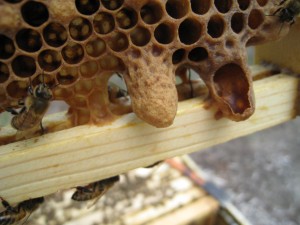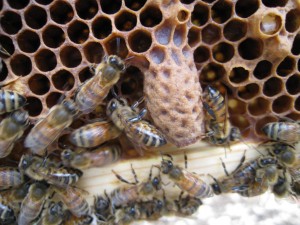Today, sort of on a whim, I went out to check the Geronimo hive. It has been and remained my strongest hive since starting beekeeping in the Spring of 2009. At the last check, everything appeared to be going smoothly : 4 to 5 frames of pollen, 4 to 5 frames of capped honey in the two bottom deep suppers, 10 frames of drawn comb in the top medium super (with a few that had patches of capped honey). Add to this a healthy dose of eggs, larva and capped brood and I figured things were great. With the dearth coming on in the midst of a drought here in Richmond, Virginia, my expectations for today’s inspection were to find mostly the same with perhaps a bit less stored honey (they should be eating into some of the Spring stores now.)

Of course, that’s not exactly what I found. They did have a good amount of pollen and honey socked away, in addition to the fact that they were about half finished in drawing out a couple of frames of foundation that I had given them when I took some capped brood to start those Nuc’s for the new queens that I picked up last month. But, they also had about 10 swarm cells, 4 of which were torn open…
So, here we are in the worst time in the world for bees to go off and build a new hive and my bees have either already sent the original queen on her way (I did not find the little wench, but did find larva) or were about to. The fact that I found larva says that the queen has been here in the last week. She may still be in the hive. As to the queen cells that were torn open, they could mean a million different things (of course!), each dictating a different strategy by me!
For example, it is possible that they made hatched queens (and my old queen already swarmed), but these queens have not gotten around to killing the inhabitants of the other cells (I spent a good many minutes examining three of my larger, unhatched queen cells for evidence of Queen regicide). It is also possible that the bees tore them apart because of some failure of the queen larva (maybe she had some mites in there with her…) In fact, I have include a picture in this post that has to be an example of that. The cell’s cap is still intact, whereas the side of the cell is torn open… When a queen emerges, she comes through the end (well, that’s how everyone else’s queens emerge – it wouldn’t surprise me one bit of my queens did it differently from all of the bees of the last several hundred thousand years…) There are a million possibilities, but knowing the answer really wouldn’t help me with my current situation. I still had 7 or so cells, on frames all over the hive, to deal with.

I personally do not believe in destroying the queen cells unless you are so late in the season that the drone level may be too low to mate with the virgin. I had decided that I would try to find the queen and move her to a Nuc, where I could then take action later (my 4 Nuc’s for overwintering may need a queen at some point or maybe I would just overwinter 5 Nuc’s – but, judging from the issues with a couple of the Nuc’s, I was pretty sure that one would need a queen over the next month or so.) At that point, my hive would think they had swarmed already and the first queen to come out would just kill the others.
Unable to find my queen, it made more issues. If she swarmed, these other queen cells might be for after-swarms (what kind of insane bee swarms in this low nectar environment? I would bet big money that they would die out before Fall, if they landed in some tree hollow out there.)
Again, I had to focus. Deal with what you know. I had a bunch of viable queen cells and a probability that these bees might swarm again (or maybe were getting ready to swarm for the first time). So, I split the hive, giving equal parts brood, pollen and honey to both splits. I have come to grips with the fact that they are going to need feeding. I honestly was not looking to increase further this year, but now I am wondering about the Albo hive (my second strongest hive), out in Charles City at the Mountcastle Apiary.
At any rate, more to come on this developing situation tomorrow or Sunday. I do know that I will be a bit more active in looking at the strong hives in July going forward (when time allows.) I would have liked to have gotten ahead of this before the cells had even been capped. I hope to go through the splits again tomorrow and finally locate the queen, assuming she is still in there.

Reader Comments
Did you notice the purple eyed pupa in the upper right corner of the second picture? Ah varroa mite removal at its best, VSH working…
Doug
I had to search the internet to determine what you were talking about. I suppose this indicates that the bees tore that cell open and are getting ready to remove that drone, who probably has a bunch of mites on him?